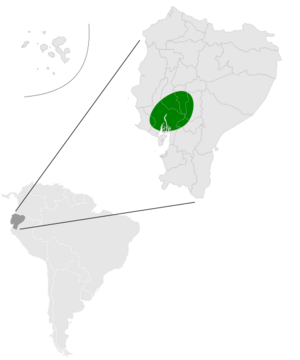Equatorial dog-faced bat facts for kids
Quick facts for kids Equatorial dog-faced bat |
|
|---|---|
| Conservation status | |
| Scientific classification | |
| Genus: |
Cabreramops
|
| Species: |
aequatorianus
|
 |
|
The equatorial dog-faced bat (Cabreramops aequatorianus) is a special kind of bat. It belongs to the Molossidae family, which are often called free-tailed bats. This bat lives only in Ecuador, which means it is endemic there.
These bats like to live in dry, tropical forests. They are now an endangered animal. The equatorial dog-faced bat eats mostly insects.
Discovery and Naming
This bat was first found by a Spanish zoologist named Marcos Jiménez de la Espada. He discovered it in November 1864. Espada found four female bats in Babahoyo, Ecuador. They were near the Guayas River inside an old tree. They were sharing their home with other bats called harmless serotine bats.
Later, in 1917, another scientist named Ángel Cabrera officially described this species. The bat's scientific name, aequatorianus, comes from a Latin word. It means "Ecuadorian," showing where the bat comes from.
This bat used to be grouped with other bats in the Molossops genus. But now, many scientists believe it is the only species in its own genus, called Cabreramops.
Where They Live
The equatorial dog-faced bat lives in dry, tropical forests. You can find them in the west-central part of Ecuador. So far, these bats have only been found in two places in the world.
Protecting the Bat
The IUCN is a group that checks on animals around the world. They first listed this bat as "vulnerable" in 1996 and 2008. This means it was at risk.
In 2016, the IUCN changed its status to "endangered." This means the bat is in much greater danger of disappearing forever. They are endangered because they live in very few places, fewer than five spots. Also, the places where they live are shrinking and becoming less suitable for them.
The area where they are found is about 4,000 square kilometers (about 1,544 square miles). A big problem for these bats is habitat destruction. This happens when their forest homes are cut down or changed. People are turning these forests into farms. Also, bats living in swampy areas are threatened by aquaculture. This is when people raise fish or other water animals in those areas.


